James Harden's Case For MVP In Seven Charts

Mercifully, the never-ending MVP debate between James Harden, Russell Westbrook, LeBron James and Kawhi Leonard is nearing a conclusion. Harden’s Rockets scored a convincing victory over Westbrook’s Thunder on Sunday, giving Houston a 3–1 series lead this season and dropping Westbrook to 3–9 against the Rockets, Warriors, Spurs and Cavaliers.
But viewing that latest head-to-head result as the turning point in this conversation would be a mistake. Ditto for backing Leonard on the basis of his sensational block on Harden a few weeks back. This season, the individual performances have been so far off the charts that they demand a wider lens, one that takes into account recent history, MVP comparison points and team performance.
With those factors in mind, let’s make the case for Harden as MVP in seven charts and tables.
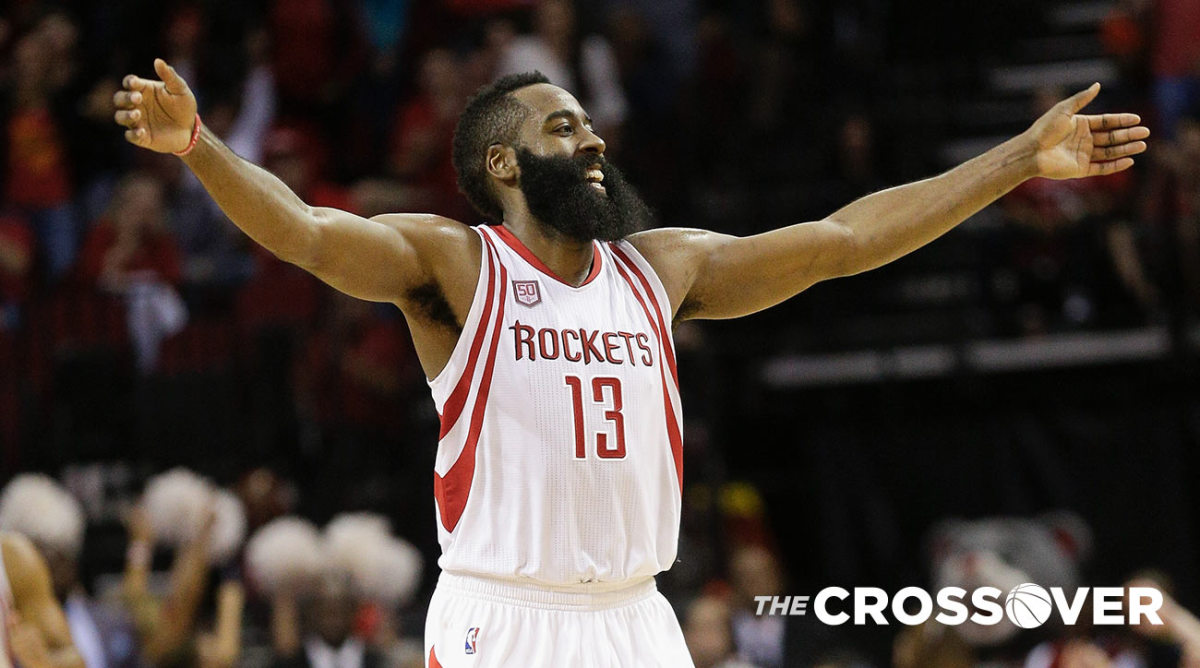
1. James Harden’s averages are off the charts
The strongest argument for Westbrook as MVP is, without a doubt, his historic run at becoming the first player since 1962 Oscar Robertson to average a triple double. Entering Monday’s action, Westbrook was averaging 31.3 points, 10.5 rebounds and 10.4 assists, insane numbers that most assumed he wouldn’t be able to keep up over the course of an 82-game season. For some voters, the MVP conversation will be determined entirely by whether Westbrook takes his spot alongside Robertson.
Rockets GM Daryl Morey and Houston fans have been vocal in recent weeks that this conversation shouldn’t boil down to “Triple doubles or bust.” The gist of their argument is that the triple double cut-offs are an arbitrary measure and that Westbrook’s ability to average a few more rebounds than Harden shouldn’t override Houston’s advantage in the standings and Harden’s many other merits.
The Beard: James Harden Untangles His Life And Game
It should be obvious that both sides have merit: Triple doubles can be magical, eye-popping and a handy measure of superb value without being the end-all, be-all for the NBA’s most coveted award. The real danger in focusing on Westbrook’s triple doubles comes in overlooking Harden’s own historic stat line. Entering Monday, Harden was averaging 29.4 points, 8 rebounds and 11.3 assists, numbers that haven’t been matched by any player, including Westbrook, since Robertson in 1965. James, meanwhile, has also posted crazy numbers even by his incredibly high standards (26.1 PPG, 8.4 RPG, 8.8 APG).
To provide better context, let’s look at how Westbrook, Harden and James shape up against the 10 most productive NBA MVPs of the three-point era. In the following chart, a player’s points, rebounds and assists are added together to measure their overall per-game production. This year’s players appear in red and are marked with an asterisk.
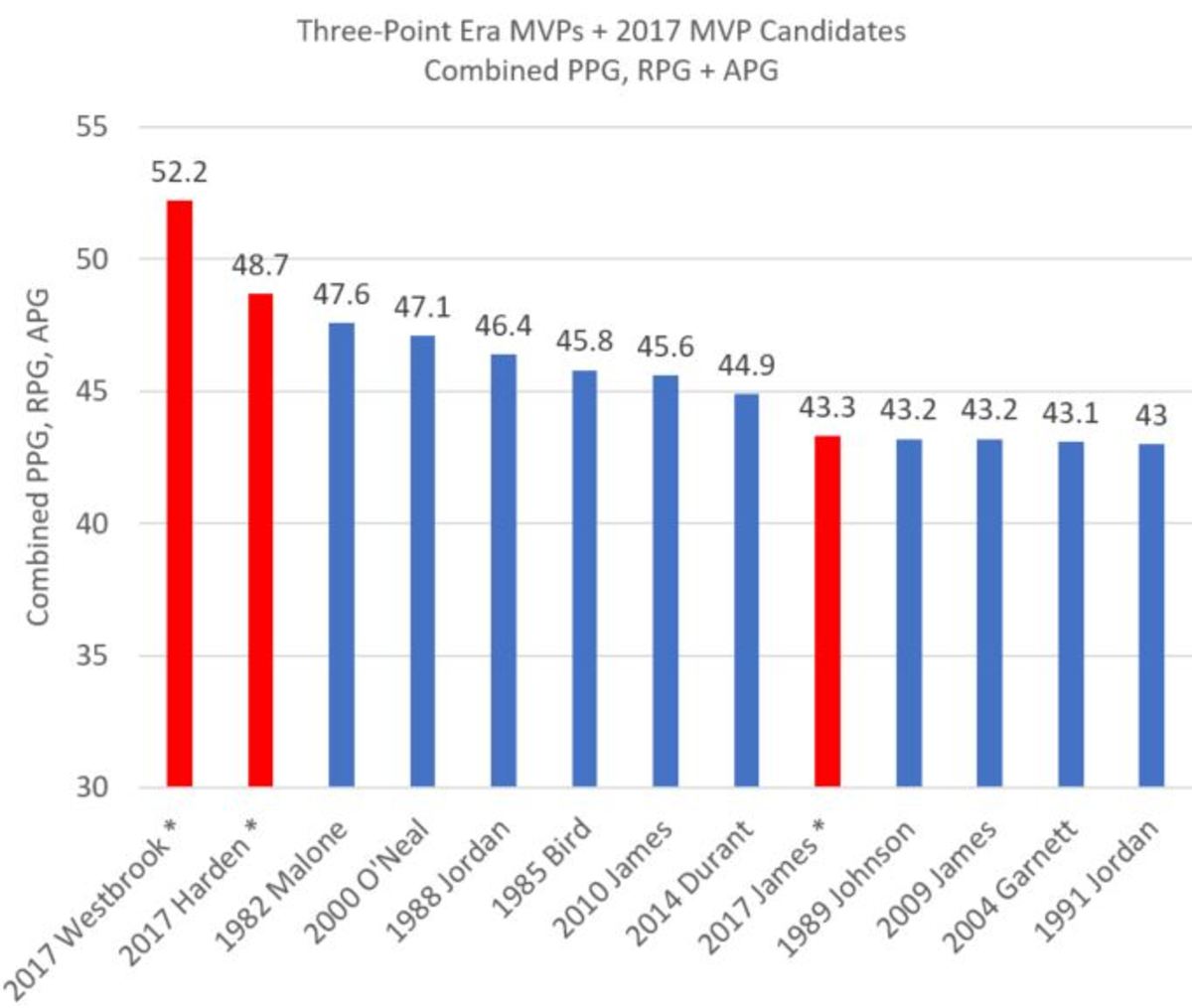
Note that both Westbrook and Harden currently top every single NBA MVP in combined points, rebounds and assists. That includes peak Michael Jordan, peak James, peak Larry Bird, peak Magic Johnson and super productive centers like Shaquille O’Neal and Moses Malone.
While Westbrook supporters might see his No. 1 ranking on this chart as fuel for the argument that this should be an open-and-shut case, a more balanced read would conclude that their concurrent dominance warrants a deeper look at other possible factors. Think about it this way: Would Westbrook really be “snubbed” if he was beat out for MVP by a player with more combined points/rebounds/assists than any other MVP since 1980? The answer to that rhetorical question should be a firm “No.”
2. Harden holds noticeable shooting efficiency advantage
The chart above clearly establishes that both Westbrook and Harden have been monster producers, the likes of which the NBA hasn’t seen in the modern era. But how, exactly, are they getting it done?
A quick glance at their shooting splits might lead to the conclusion that Harden holds a narrow lead:
• Harden: 44.8 FG%, 35.2 3P%, 84.8 FT%
• Westbrook: 42.2 FG%, 33.6 3P%, 83.9 FT%
However, Harden’s better overall shooting coupled with his much greater reliance on the three-point ball—he’s the only player other than Stephen Curry to attempt nine threes per game—gives him a clear True Shooting Percentage advantage. Entering Monday, Harden boasted a 62 TS% and Westbrook owned a 54.9 TS%.
The following chart, which compares True Shooting Percentage to Usage Rate, should help provide some context for what that means. This chart includes every MVP from the three-point era along with Harden, Westbrook, LeBron James and Kawhi Leonard, the consensus top-four MVP candidates this year. This year’s are marked with an asterisk.
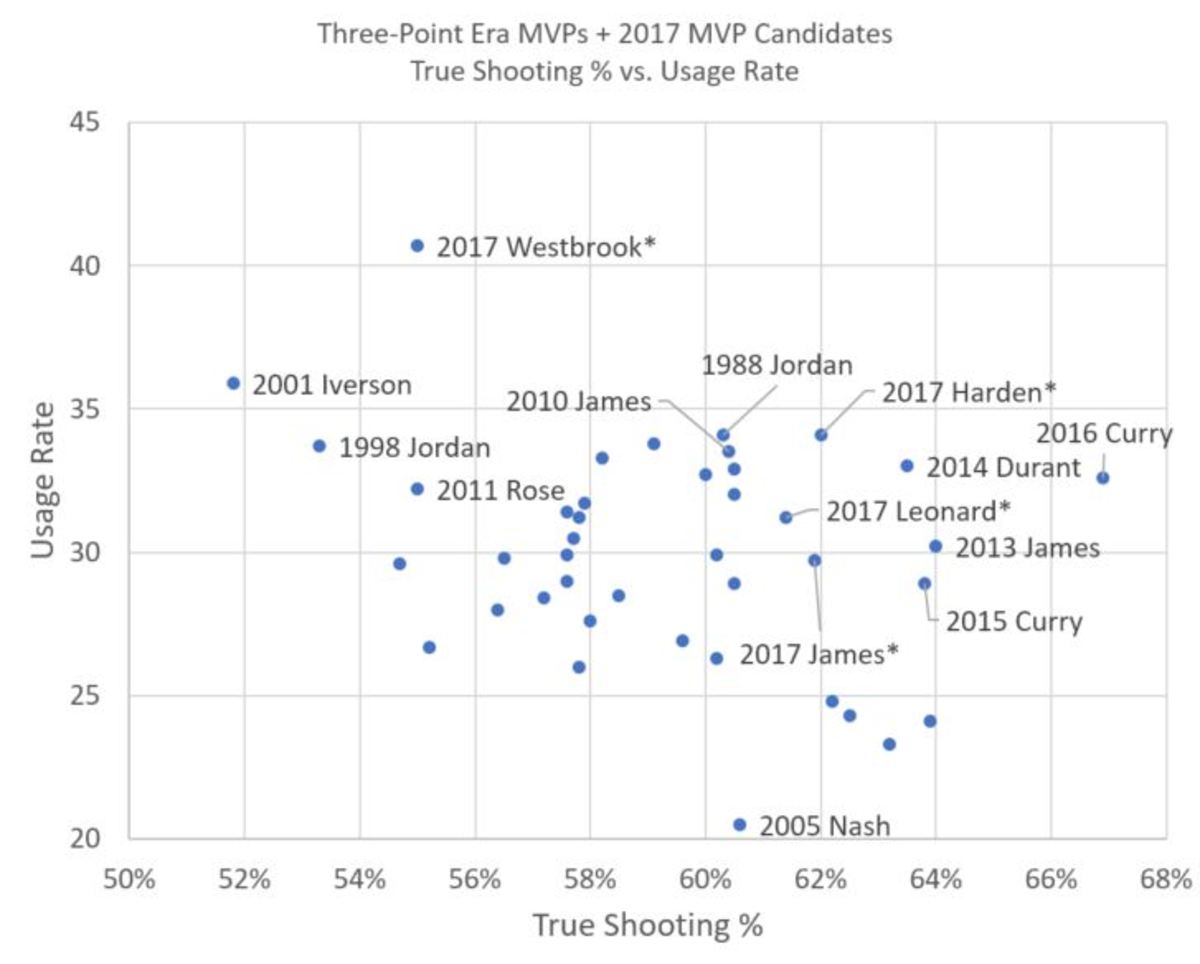
This chart is fascinating for a few reasons. First, note that Westbrook’s record-setting 40.7 Usage Rate makes him a complete anomaly compared to MVP winners. He’s using way more possessions than 2001 Allen Iverson and 1998 Michael Jordan, who both rank among the most ball-dominant MVP winners since 1980.
Second, though, note how recent MVP winners—guys like 2016 Curry, 2015 Curry, 2014 Kevin Durant, 2013 James—have managed to maintain very high True Shooting Percentage numbers despite healthy usage rates. Also note how Harden, James and Leonard all fit the high-usage, high-efficiency mold this year while Westbrook (sky-high usage, mediocre efficiency) clearly does not.
Third, and most importantly, Harden is a more impressive outlier on this chart than Westbrook. His usage rate currently exceeds Jordan’s MVP seasons while his efficiency exceeds all three of his major MVP competitors plus a vast majority of the MVP winners over the past 37 years. The ideal lead option shoulders a monster burden without killing his shooting numbers. Harden, like Curry, Durant and James before him, fits that bill. Westbrook doesn’t.
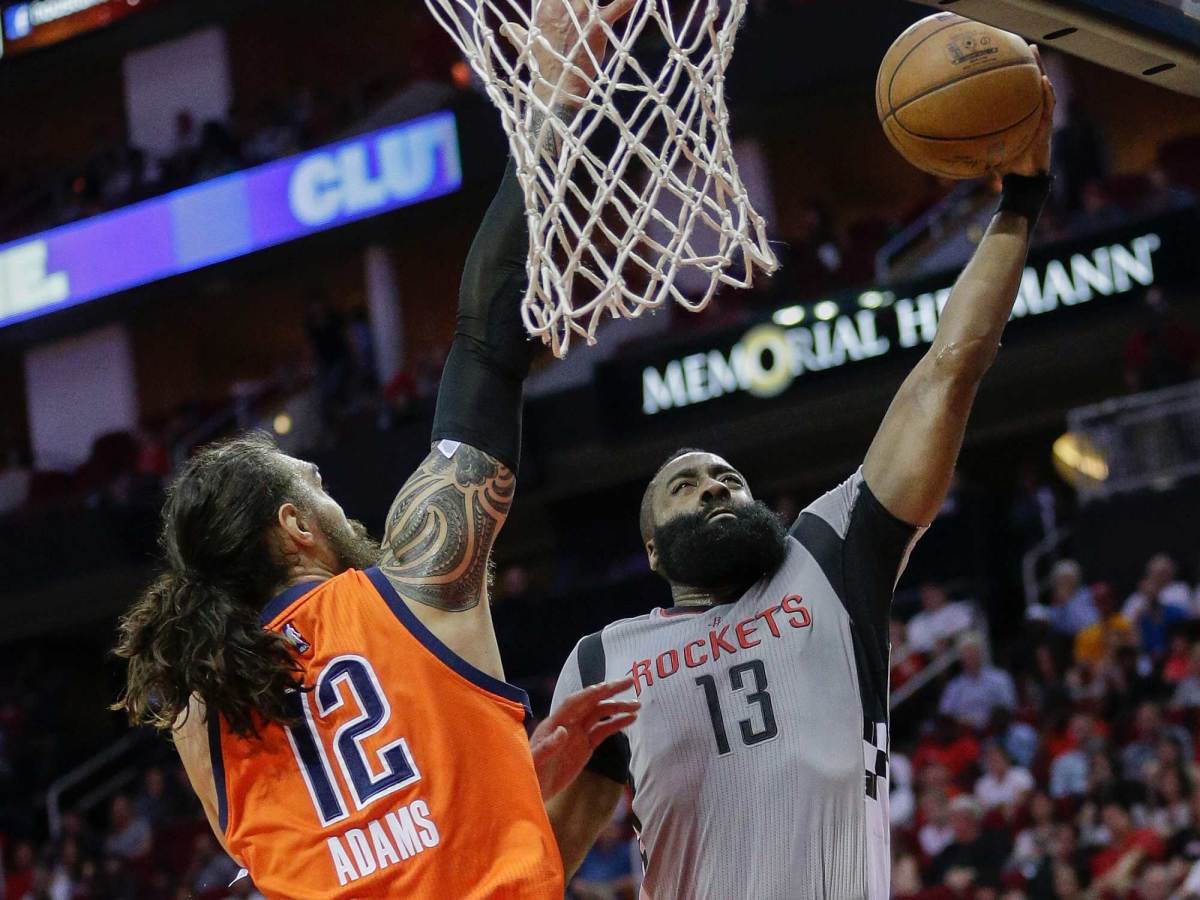
3. Harden gets his points in the best ways
Over the last decade, Houston has played a central role in reshaping how basketball is played. The simplest version of this story should be familiar by now: three-pointers, lay-ups and free throws are “good shots” while contested mid-range shots are “bad shots.”
This season, coach Mike D’Antoni’s Rockets have been neck-and-neck with the Warriors when it comes to both offensive rating and True Shooting Percentage. That’s a remarkable feat given that Houston has just one All-Star, while Golden State has four.
While Harden ranks in the top 20 in baskets made in the restricted area, he has truly distinguished himself as a combo three-point shooter and foul-drawer. This table shows which players have scored the most combined points from behind the arc and at the line during the Three-Point Era. Note that Harden still has nine games left to play and will soon pass his own mark from last year and likely finish second to 2016 Curry on this list. That’s no shame, by the way: Curry shattered every three-point shooting record in the book last season. This year’s players appear in red and are marked with an asterisk.
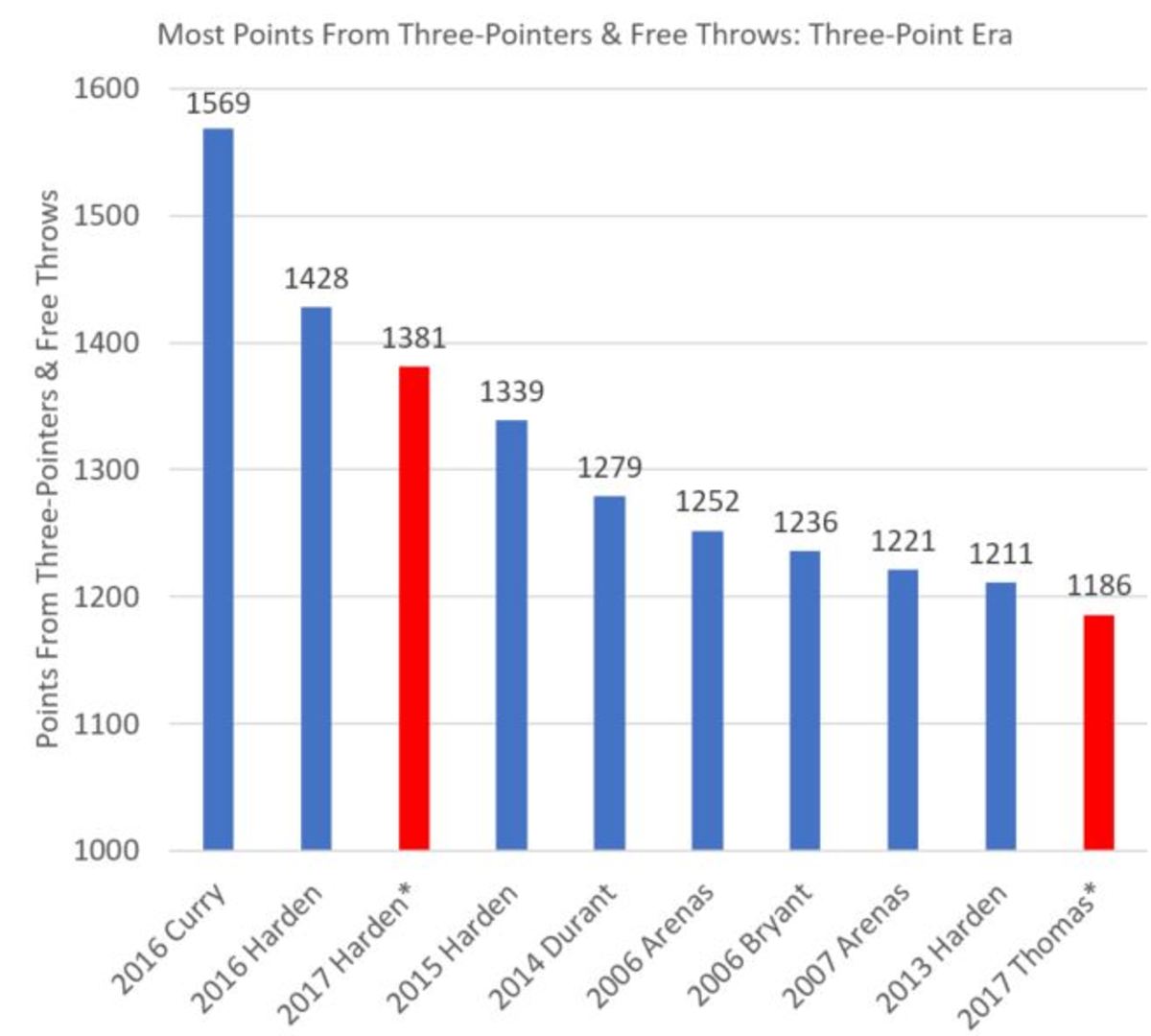
Harden’s placement on this chart isn’t trivial. Under D’Antoni, Houston has successfully translated his individual strengths—range, power on the ball, craftiness—into defining team-wide attributes, ranking first in both three-point attempts and free throws attempts. As with Curry’s extraterrestrial three-point shooting ability in recent years, MVP voters would do well to reward Harden’s ability to craft a clear identity and playing style for his team this season.
4. Harden is the NBA’s most productive playmaker for others
Harden would have an MVP case based on his volume scoring and pronounced role alone. But that’s really only half the story when it comes to his offensive impact. A gifted, confident passer with brilliant pick-and-roll orchestrating skills and impressive cross-court vision, Harden has flourished as a play-maker for others in his “new” point guard role under D’Antoni.
For background: Harden’s 11.3 assists per game would place him in the top-five all-time among MVPs, topping everyone except Johnson (1987, 1989, 1990) and Nash (2005). That’s right: Harden is putting up better assist totals than Steve Nash, Oscar Robertson, LeBron James and others during all of their MVP campaigns.
Ranking The NBA's Seven Most Hopeless Teams
But even that undersells his ability to generate offense for his teammates because so many of his assists lead to three-pointers for teammates like Ryan Anderson, Eric Gordon, Trevor Ariza, Patrick Beverley and midseason addition Lou Williams. Indeed, Harden’s 27.5 points generated by assist leads the league this season by a healthy margin and it’s the highest mark posted during the four seasons the stat has been tabulated by NBA.com.
This chart shows the top 10 play-makers of the past four seasons, as judged by most points generated by their assists. This year’s players appear in red and are marked with an asterisk.
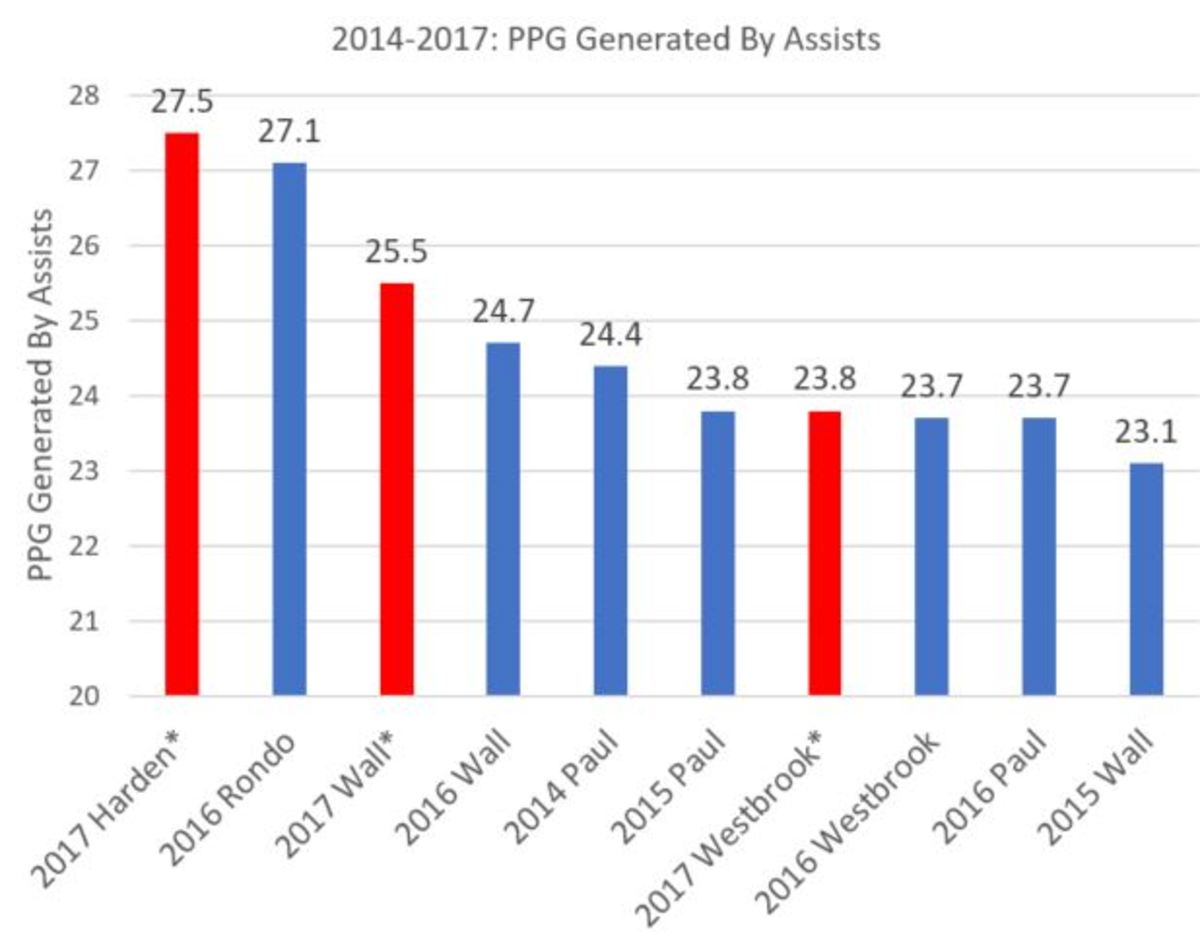
Note that Harden tops Westbrook, James, Chris Paul and a host of other premier passers in this category. Amazingly, he even edges 2016 Rajon Rondo, who spent his entire Kings tenure with the sole purpose of chasing passing stats like this one. In Sacramento last year, Rondo’s desire to set up his teammates came at this expense of his own offense and his team’s offensive efficiency numbers. In Houston, Harden’s set-up skills keep his many hungry teammates happy and ensure that defenses pay if they try to load up on him.
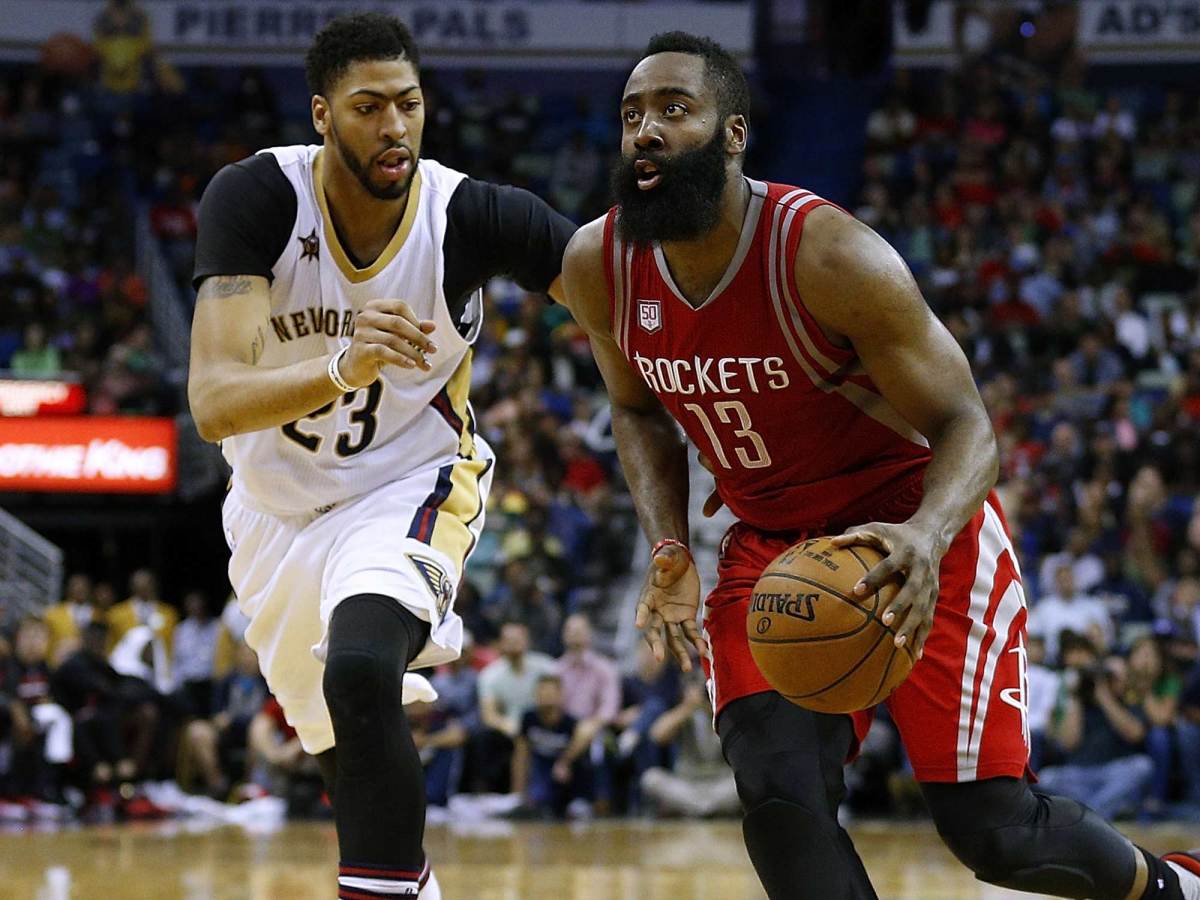
5. Harden is leading an all-time offense
Now let’s tie some of these threads together. What happens when a player is an elite stat producer, a league-leading playmaker for others, and a finely-tuned efficiency machine surrounded by an offensive system that’s completely designed around him? Well, lots of good things.
Westbrook’s supporters might argue that he, like Harden, is also a prolific one-man offense. The basic offensive efficiency numbers show a clear separation between the outfits driven by these two players: The Rockets’ attack ranks No. 2 overall while the Thunder ranks No. 15. Simply put, Houston has been excellent while Oklahoma City has been average.
Yes, Westbrook is singlehandedly propping up the Thunder. When he leaves the court, Oklahoma City’s offensive rating drops by 10.5 points. By comparison, Houston’s offensive efficiency drops 6.8 points without Harden, in part because D’Antoni has a deeper supply of scoring weapons and shooters at his disposal.
Steph Curry Can Still Decide Everything
What’s more impressive: Carrying a fairly weak cast to an average offense and a good record, or leading a team of non-stars to one of the best offenses in recent memory and one of the league’s best marks?
One can argue that Harden hasn’t gotten enough credit for Houston’s team success this season because he’s playing in Golden State’s shadow. The Rockets’ 115.1 offensive rating is actually the third-best mark of the last decade, trailing only the 2017 Warriors and the 2010 Suns. In most years, Harden would be leading the league’s most potent attack. In many years, he’d be doing it by a wide margin.
The following chart shows every team’s offensive rating and winning percentage since 2001. The best teams with the best offenses appear in the upper right corner of the plot while the worst teams and the worst offenses appear in the lower left. This year’s teams appear in red and are marked with an asterisk.
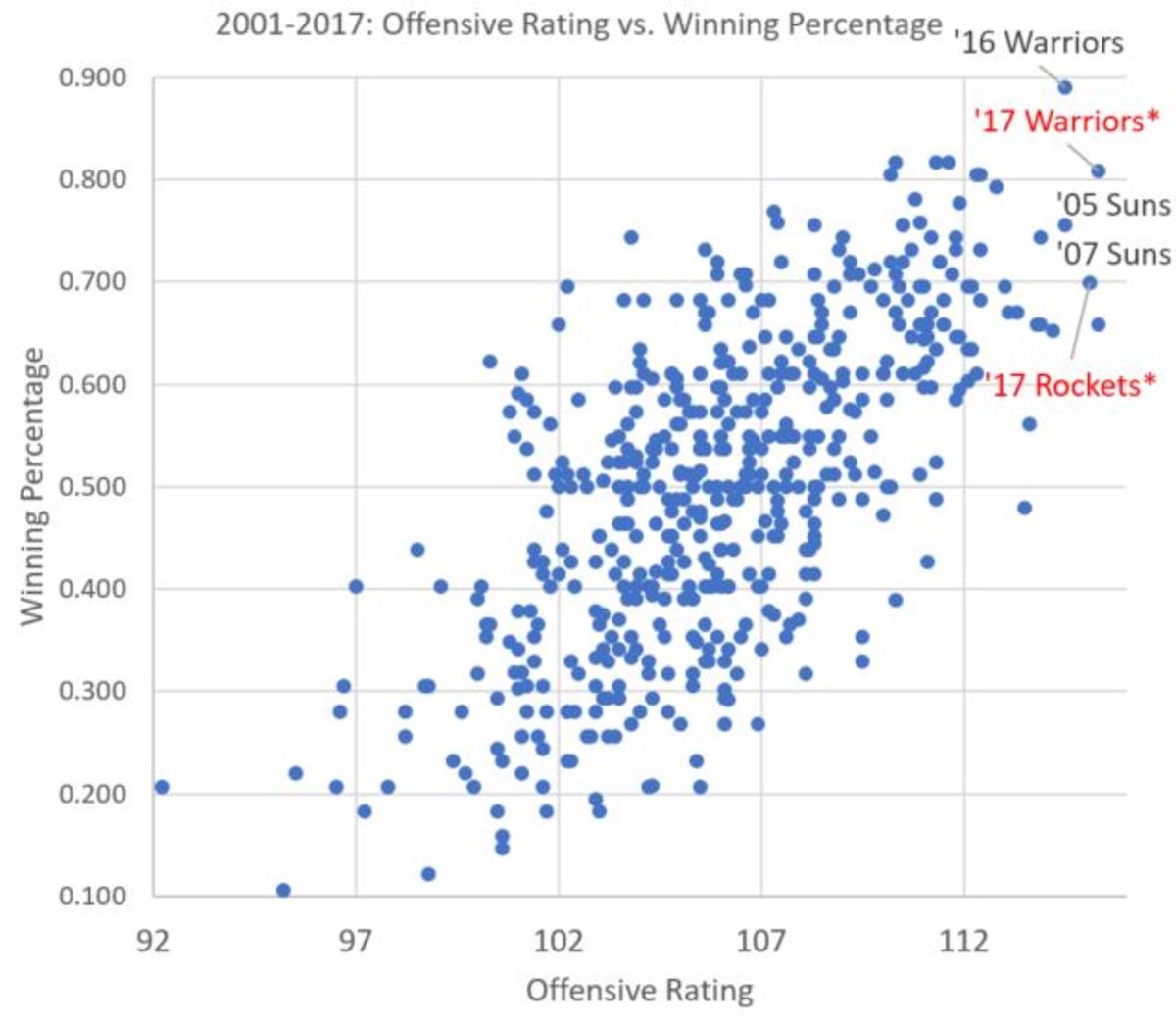
Note that the 2017 Rockets are a clear outlier. Their performance has been absolutely amazing, albeit not quite as amazing as the 2017 Warriors. The visual effect here should help reinforce how special Houston’s season has been offensively. When viewing the NBA’s last 17 seasons, Harden’s Rockets definitely stand out from the crowd.
6. Harden is the focal point of a cutting-edge attack
Let’s be honest: style points and narrative wind up mattering a lot in the MVP conversation. Once Durant left in free agency, Westbrook was rightfully anointed as David to the Warriors’ Goliath. His insane usage, relentless approach, near-nightly triple doubles and clutch performances combine to reinforce his case as an underdog who stops at nothing to will his team to victories. Part of Westbrook’s charm is his eagerness to race head first into every challenge, no matter how difficult.
Harden’s approach, as evidenced in Houston’s 137–125 thrashing of Oklahoma City on Sunday, has been different. His defining characteristic has been to make the difficult look easy. That can come in many forms: behind-the-back passes to shooters, threaded dimes to alley-oop finishes, stomping drives for lay-ups, step-back three-pointers, end-to-end baskets in transition, you name it.
For the Thunder, it often feels like every basket and many of their wins are a struggle. For the Rockets, the points come early and often, and they rarely cease. Sunday’s win was Houston’s 19th team topping 125 points, a league-leading mark. It was also the 10th time this season they have connected on at least 20 threes, which is more than every other NBA team combined.
Three-pointers have been all the rage for a number of years, so sometimes that trend can have a blurring effect. After all, the Warriors still have the Splash Brothers, the Cavaliers have been launching more than ever, and everyone from the respectable Celtics to the pathetic Nets have taken to bombing in volume this year. With that in mind, it’s critical to note that Houston remains in a class entirely by itself when it comes to the three-pointer and that its strength in that category has had an aesthetic impact. Harden and the Rockets have “made it look easy” on so many nights this year because they are spectacularly effective at, and spectacularly committed to, the sport’s most devastating weapon.
This chart shows just how far ahead Houston remains from the rest of the pack when it comes to launching from deep. This year’s Rockets appear in red and other 2017 teams are marked with an asterisk.
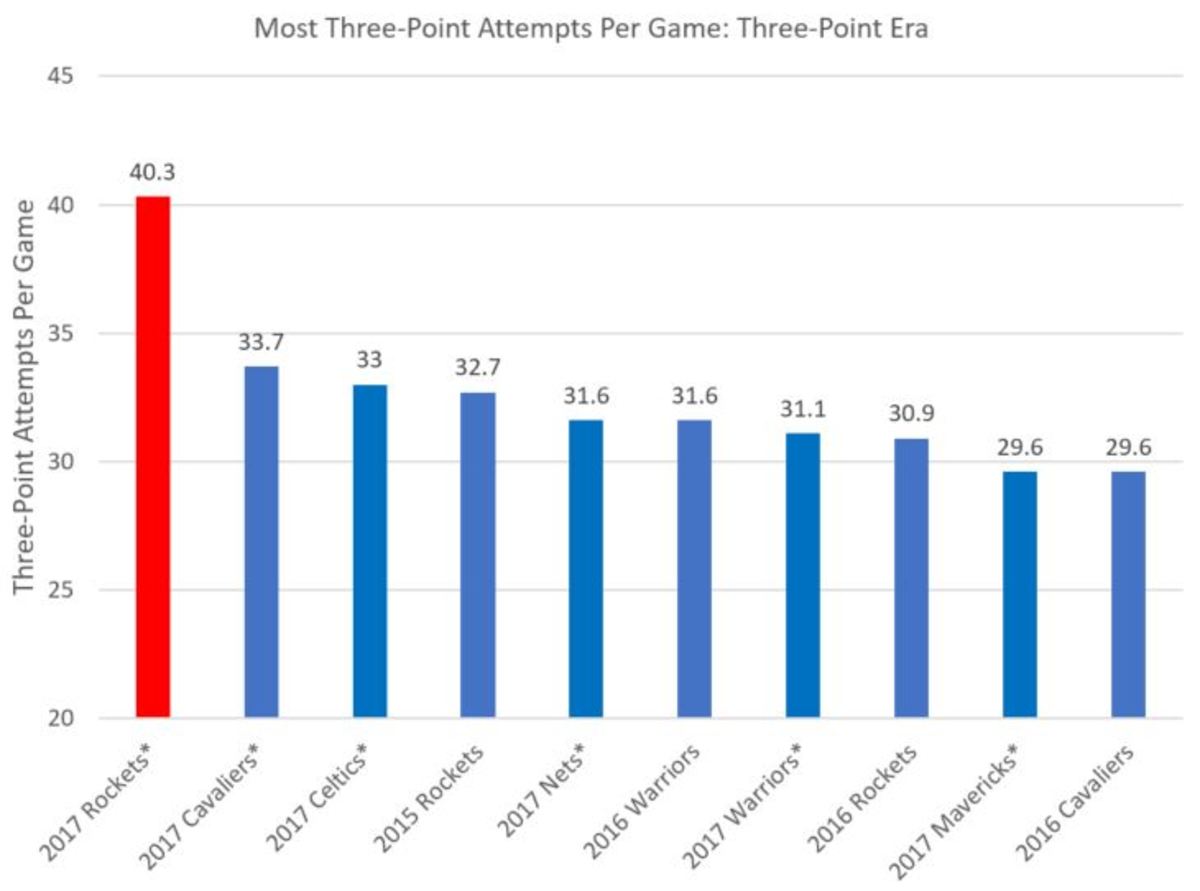
Note that this chart covers the entire Three-Point Era; the top 10 teams in terms of three-point attempts have all taken place in the last three years. These teams include some of the league’s best players—Curry, James, etc.—and some of its highest-performing offenses. And yet Harden’s Rockets remain way out in front.
The Harden/Westbrook choice for voters on this topic is straightforward. Is it really wise to reward Westbrook for the difficulty of his feats if Harden has mastered a more effective, less grisly approach? This same argument, by the way, applied to Curry’s MVP candidacies in 2015 and 2016. “Scoring easily” should be viewed as the real virtue, even if “scoring hard” often commands more attention.
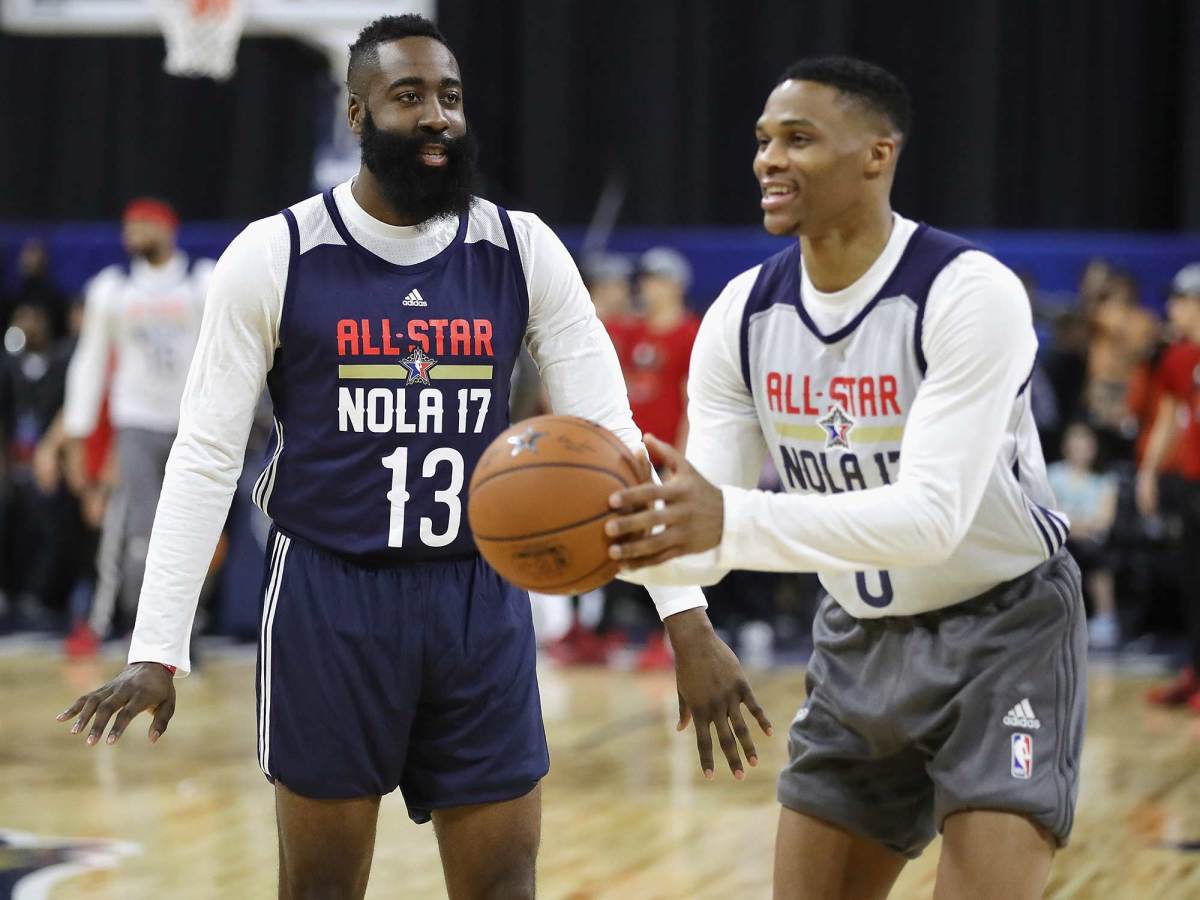
7. Harden’s Rockets are the NBA’s biggest overachievers
The bounce-back nature of Harden’s season is perhaps the easiest conversational strain for many observers to grasp. No Dwight Howard! No Khloe Kardashian! No excess weight! No early-season coaching drama! New teammates! Harden is a new man!
Overly crediting Harden for Houston’s turnaround would be a mistake. He must remain accountable for the Rockets’ messy 2015-16 season given his personality conflict with Howard, his off-court distractions and his slow start. Voting for any candidate primarily because he turned in a better season than the year before would be a mistake. Meanwhile, Westbrook’s supporters might argue that Harden has better teammates and that the Thunder, who are the West’s No. 6 seed and could move up, have also significantly overachieved.
A look back at preseason expectations, however, tells a different story. Back in October, oddsmaking service Bovada set Houston’s over-under line at 44 and Oklahoma City’s line at 43.5. In other words, Las Vegas viewed these two teams as virtually identical when the season opened. Since then, the Rockets (51-22) are on a 57-win pace while the Thunder (41-31) are on a 47-win pace. That’s a major gap in performance.
As it turns out, the Rockets haven’t just outpaced the Thunder when it comes to overachieving, they’ve blown away the entire league. This chart compares the preseason over/under lines to current winning percentage to determine the league’s biggest overachievers. Houston is tops by a healthy margin and appears in red.
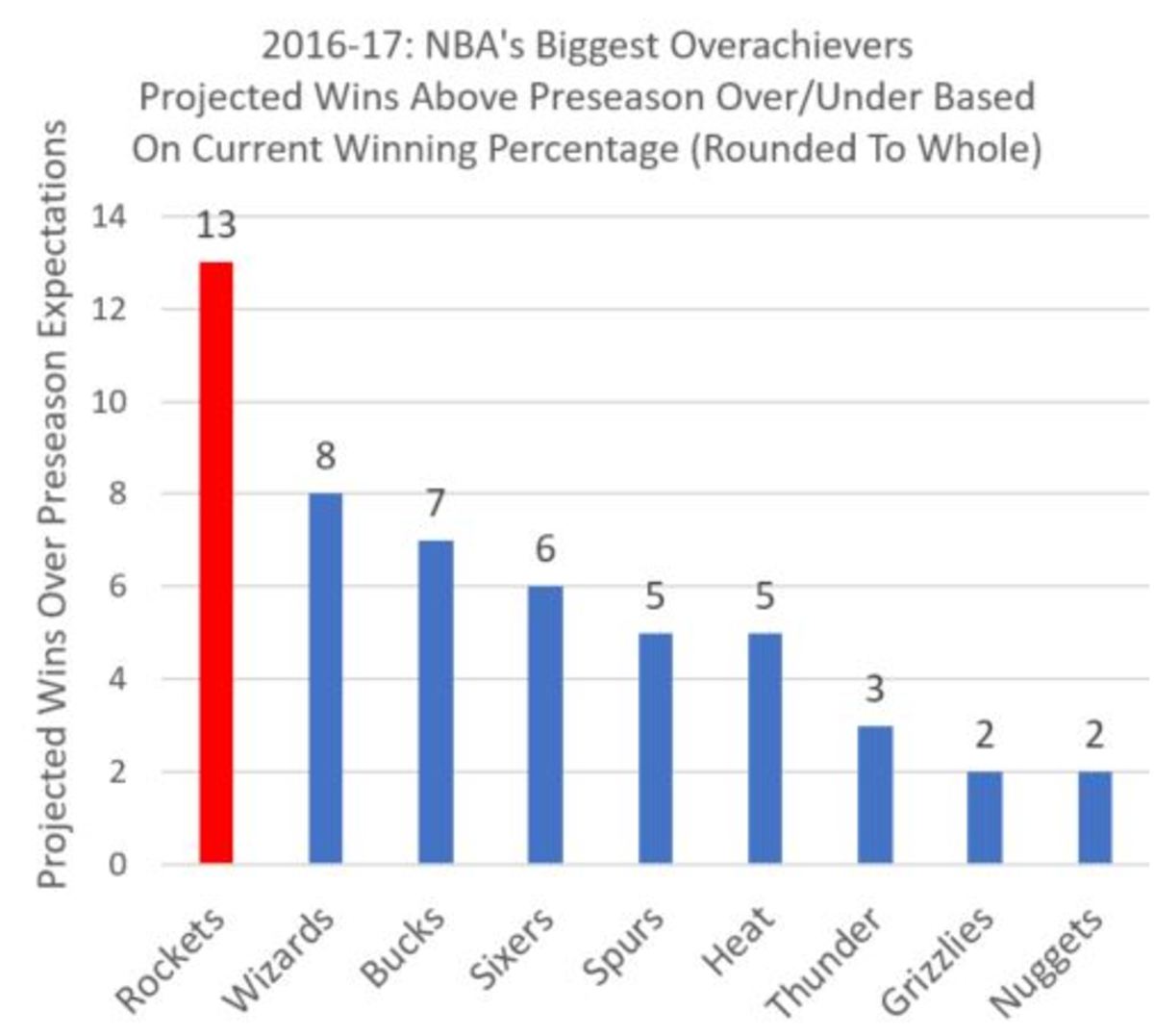
To boil down the results of this exercise, Harden’s MVP case looks like this:
1. His per-game numbers are unmatched by any MVP since 1980
2. His efficiency/usage numbers are in line with recent MVP winners and better than his fellow MVP candidates
3.His preferred methods for scoring are directly in line with current best practices
4. He is the most productive playmaker for his teammates in the league
5.He is the engine of one of the most effective and forward-thinking offenses in recent memory
6. He excels at making the game look easy
7.And his team is the NBA’s biggest overachiever and boasts one of the league’s best records.
There are arguments to be made for other candidates, including Westbrook, and voters should wait to make their final decisions until the season ends in a few weeks. As it stands now, though, Harden deserves to be viewed as the clear frontrunner.
